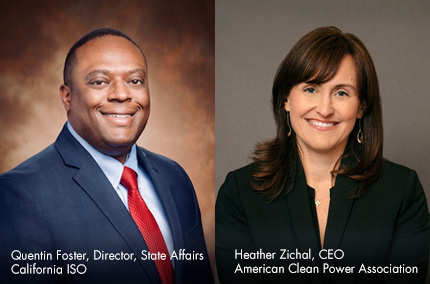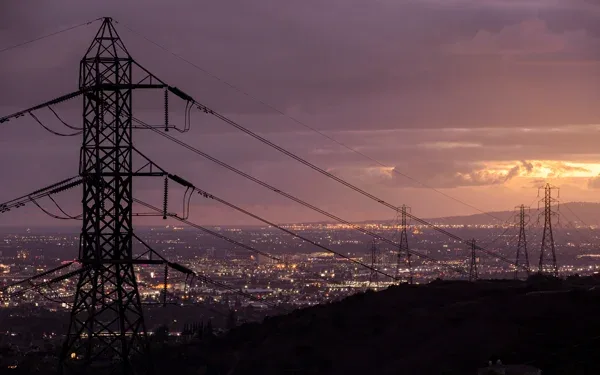Heather Zichal of American Clean Power Association discusses grid resiliency during transition to renewable energy

Recently, Heather Zichal, CEO of the American Clean Power Association (ACP), had an informal discussion with Quentin Foster, Director of ISO State Affairs. The virtual fireside chat provided a forum to discuss the challenges and opportunities facing California and other states in the West regarding grid resiliency while transitioning to cleaner sources of energy.
Ms. Zichal has had a long and distinguished career in the climate change and sustainability arenas, including her work coordinating the Obama administration’s energy and climate policies. As a leader in the renewable space, and representing one of the few organizations with comprehensive legislative efforts at the federal and state level, her unique perspective and thoughts on the future of transmission development are enlightening.
As the actual conversation was more than 30 minutes, the following is a transcript focusing on highlights of the discussion.
Edited Transcript
Quentin: Thank you for agreeing to talk. Please tell us a little bit about ACP.
Heather: We are a DC-based trade association, and what's unique about us is that we represent all clean-energy technologies. Wind, solar, storage, and transmission. And the other thing that makes us unique is we represent everybody.
We are a trillion-dollar part of the economy, we are over 415,000 workers strong, and we need to show up in in Washington and in statehouses and regionally in a way that says that.
Quentin: What is ACP focused on right now?
Heather: Let’s talk about the federal side and then the states. Our first focus is ensuring proper implementation of the recently passed infrastructure legislation, which was the first and largest investment in the nation's grid. Policies designed to stimulate the transmission build is one of our top priorities.
The second is, you can't really have a conversation about clean energy in Washington today without talking about the climate and energy provisions in the Build Back Better agenda. I believe that there is a path forward to getting the historic climate provisions that have broad support in Congress . . . you know, getting a package through. Reconciliation is going to continue to be a priority for us.
Finally, on the federal level, there is a lot of overlap between our clean energy agenda and a pro-growth trade policy in Congress, a lot of which touches on energy. So, making sure that the trade agenda doesn't get at cross-purposes with what we need to do with the deployment of clean energy is another priority.
For the states, we organize our advocacy efforts across four different discrete regions, and one of those includes ACP California. We're pleased to see the ISO Draft Transmission Plan and transmission development taking a more prominent role in state discussions around energy.
Quentin: What role do you see storage and perhaps other technologies like offshore wind playing in the next 10 to 15 years?
Heather: Energy storage will be the central enabling resource for a high-renewables future. Utilizing our current day technologies, we are capable of moving our power system most of the way to full decarbonization.
California hosts not only the biggest energy storage facility in the world, but it hosts four of the five largest energy storage systems in the nation, so California is kind of the perfect example of where the world is headed. Energy storage is going to provide the needed flexibility for a power system that can reliably manage electrification of transportation, heating and other parts of the economy.
I also believe energy storage is key to ensuring that power remains resilient, whether that's related to wildfires, heatwaves, or extreme weather events. They’re not going away. We know they're only going to increase in frequency and energy storage is going to be really critical to ensuring that households and businesses have continued electric service during significant climate-related disruptions.
Also, under the banner of storage, long-duration storage technologies are almost assuredly going to get started in California, thanks to the state's commitment to decarbonization, and the resource planning targets.
Lastly, I'd say offshore wind is equally an essential component of California's renewable energy mix, for a number of reasons. Its generation profile is an ideal complement to other renewables in the state. Second, the potential of the resource in California is immense, with over 200 gigawatts of wind energy available to be harnessed off of California's coast.
If we could just harness 10% over the next 20-plus years, offshore wind can constitute a significant slice of the renewable energy generation pie.
Quentin: What do you perceive as the main barriers to the development of transmission infrastructure at the federal level, and how can they be solved?
Heather: The roadblocks kind of boil down to how we plan, pay for and permit transmission. And those are kind of the key areas that are impeding grid development. The roadblocks include a Balkanized transmission planning and permitting processes and a failure to recognize the benefits of an expanded and modernized grid and what that could mean. So if I break it down a little bit, the planning process does not recognize the benefits of an expanded and modernized grid. And so transmission is generally planned separately for reliability, economic and public policy purposes, rather than under a holistic approach that considers the joint benefits. We also see neighboring planning authorities using different and sometimes incompatible planning models and methods that prevent agreement on interregional lines.
On the permitting side, when it comes to permitting lines that benefit many states and the nation, this is performed at the state and local levels, which slows development of some of these regionally beneficial investments. And then on the cost allocation piece of the puzzle, cost allocation principles should spread the cost broadly to all beneficiaries.
We need to see continued policy reforms at the federal level in the next few years if we're really going to meet our clean energy goals, because transmission just takes so long to build.
And some of the things that we, as the American Clean Power Association have been engaging with FERC on are to encourage its current path of revisiting and reforming its transmission planning and cost allocation procedures, making sure that FERC and DOE (Department of Energy) make use of its recently reinvigorated transmission corridor and siting authorities. And then we talked a little bit about the bipartisan infrastructure legislation. DOE has a lot of new authorities from that legislation, as well as its existing authorities. And I really think those can be used to help catalyze long-haul transmission development.
Last but not least, you know, we're spending a lot of time in the broader conversation around the reconciliation package or Build Back Better, making sure that the transmission investment tax credit that’s part of that stalled legislation continues to be part of any package that moves forward.
Quentin: Do you have a sense that the barriers within California are quite similar to some of the federal issues that you just mentioned? Or do you think that California's issues are unique to California?
Heather: I would say every region has its own specific impediments for transmission deployment, but better planning, permitting, and cost allocation are really going to be needed across the board.
In terms of California specifically, proactive transmission planning that considers integrating potential renewable resources on public lands needs to be considered. Wind and solar resources on federal and state lands are often hard to develop, due to the time that it takes to permit clean energy infrastructure on them. To that end, we must ensure California offshore wind, onshore wind from the Mountain West, in-state solar, and hydro are all part of the regional energy mix.
Accomplishing California’s energy goals with only in-state resources would be incredibly expensive and less reliable.
Quentin: This is a good way to segue into the inevitable discussion around expanding regional collaboration. Do you think an RTO in the West is part of that solution that you just mentioned, to unlock that diverse set of resources?
Heather: The short answer is yes. Currently, the West runs 38 separate balancing authorities, each with their own operations, resources and reserves. Obviously, that is going to limit the ability to deliver clean energy over large areas in an efficient manner. In an RTO, renewable electricity resources can be more efficiently developed and integrated with greater market penetration than what individual utilities can achieve alone.


